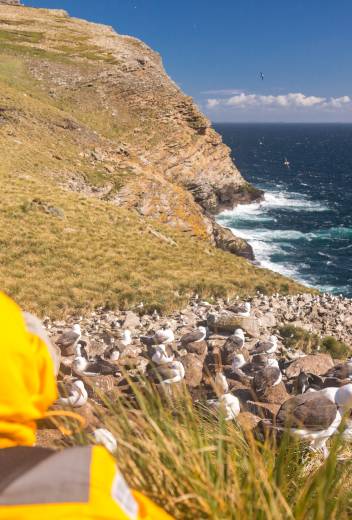As your ship approaches the Antarctic Peninsula and you catch your first glimpse of craggy, snow-covered rock faces towering over frozen beaches below, you’ll feel drawn to the deck. Without fail, Quark staff and passengers navigate towards the bow, marveling at the sheer magnitude of the seventh continent as it grows closer.
Now imagine a slight disturbance in the glass-like water ahead – a ripple, then a splash. Just beneath the surface, you see a dark, hulking mass cutting through the water between the ship and the icy beach.

Humpback and Orca Sightings Surprise and Delight at Wilhelmina Bay
A magnificent humpback whale breaches the surface, churning the water below as it thrusts into the air, pivoting and slowing, before crashing violently back into the ocean.
Not far away, the ocean again begins to stir. Black dorsal fins slice through the undulating wake of the humpback’s plunge. As they breach and jump higher, seemingly egging one another on, you count over a dozen killer whales, or orcas, playfully parading for your camera.
Now, imagine spotting an incredible 50 whales, both orca and humpbacks, in a span of just a few hours!
That was the experience shared by Quark passengers and staff at Wilhelmina Bay in January, 2014. A compilation of the amazing video footage and still photos showcases dozens of whales playing and preening, often in close proximity to delighted passengers watching from Zodiacs.

When to Visit Antarctica for the best Whale Watching
Jake Morrison, Operations Manager at Quark, recommends the mid-to-late Antarctic season as the optimal time for viewing active whales.
“Mid-February to mid-March is really the ideal time to visit Antarctica if you have a great interest in whale watching expeditions,” he says. “It’s a short season — five months in total. There are benefits to visiting at different times; for example, the glaciers and ice formations are really incredible early in the season. But whale watching can be truly amazing in the February to March window.”
In Wilhelmina Bay, whales feast on krill, a tiny species of massive importance in the Antarctic ecosystem. The 24-kilometre wide bay is one of the first experiences many passengers have with Antarctica, given its location between the Reclus Peninsula and Cape Anna along the west coast of Graham Land on the Antarctic Peninsula.

Discovering “Whale-amina Bay”
While we’re at the whims of marine mammals themselves and cannot guarantee sightings, whale watching is so fantastic in this area that some call it “Whale-amina Bay.” This is also a popular spot for photography (including polar selfies!), given its dramatic geography, with steep cliffs and an almost perfectly diamond-shaped peak over the water.
While in Antarctica, you may have the opportunity to view humpback, minke and killer whales (Orcas). Less frequently, passengers catch a glimpse of the more elusive blue, fin, sei, southern right or sperm whales.
To learn more about the best Antarctic expeditions for whale watching, contact one of our experienced Polar Travel Advisers and start planning your perfect whale-watching cruise today!









